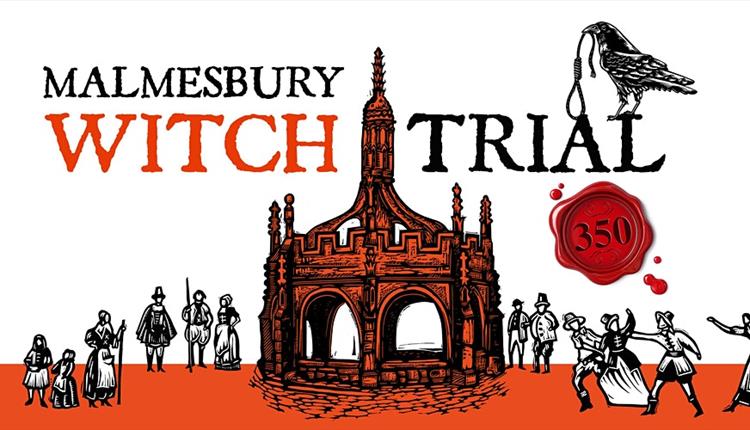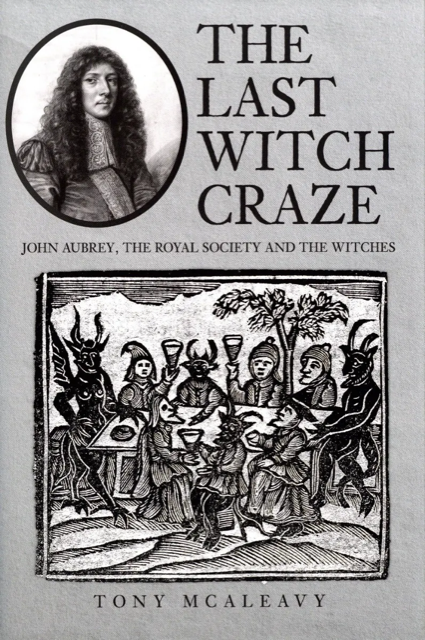In 1672 fourteen people from Malmesbury, mostly elderly local women, were accused of witchcraft or being accomplices to witches. This was no laughing matter. The penalty for witchcraft was death. Leading families in the town had become convinced that an organised coven was active in the area, intent on harming and murdering the children of anyone who antagonised them. Eventually four were put on trial for their lives at the county assizes in Salisbury.
We know about the trial of 1672 from several sources. The 17th century writer, John Aubrey, knew Malmesbury well. He lived not far away from the town in the village of Kington St Michael. In the 1680s Aubrey wrote about the trial in his Natural History of Wiltshire. Aubrey said that the women were accused of strange things including flying about on sticks or staffs! He described how a friend called Sir James Long interrogated the suspects and had written a pamphlet about the trial.
Until recently it was thought that Long’s pamphlet had been lost but a fragment of this document has now come to light.While other sources provide vital information, the key to a detailed understanding of what happened in Malmesbury during the trial of 1672 is the account of Sir James Long. According to him it all began much earlier. The events of the early 1670s were linked to an outbreak of persecution of women suspected of witchcraft in the 1640s and a longstanding grudge in the town that had persisted over three decades. So Long begins his narrative of 1672 nearly 30 years earlier at the outbreak of the English Civil War
Long told the story of a woman called Alice Elgar from the Malmesbury suburb of Westport. She was widely feared and despised as a witch. Long explained how in 1643 a combined mob of local people and parliamentary soldiers attacked Alice in near the Market Cross. Traumatised by this experience Alice Elgar went home and killed herself and as a result was denied a Christian burial in the churchyard of her parish church, St Mary’s Westport. Long went on to explain that two years later another Malmesbury women was identified as a witch. This was Goodwife or Goody Orchard. Long explained that Goody Orchard was a friend of Alice Elgar and was also known in the town as a witch. One day she went begging for yeast at the house of Hugh Bartholomew, a brewer. The door was opened by his daughter, Mary. The Bartholomew family are well recorded in the parish register and a result we know that young Mary was about ten years old when she opened the door to Goody Orchard. This was a fateful moment in the history of the witches of Malmesbury.
Young Mary refused to help. Goody Orchard became angry and said threateningly, ‘Then you will give me none? It were better for you, you had’ and went away muttering darkly to herself. Believing Goody Orchard to be a witch, Mary of course interpreted this as a threat of harm through witchcraft. A locked wooden chest made of expensive imported cyprus wood, containing the money of Hugh Bartholomew, was mysteriously damaged after the visit of Goody Orchard and her threat to the girl. The family was convinced that they had been bewitched. Fearing for her life Goody Orchard as someone accused of witchcraft went on the run.
The people of Malmesbury next heard of Goody Orchard ‘three or four months later’ when she was in Salisbury Gaol, having been arrested for carrying out witchcraft in Burbage near Marlborough. Word got back to Malmesbury that the ‘witch’ had been captured and Hugh Bartholomew and his daughter, young Mary, travelled to Salisbury to testify against her. The result of the trial was the execution by hanging of Orchard. Goody Orchard was hanged in part because of the testimony from the 10-year-old Mary Bartholomew and, according to Long, before her death the condemned woman put some sort of curse on the little girl.
Long’s account then moves ‘fast forward’ from 1645 to 1672. According to Long, Mary Bartholomew had grown up and become ‘Mistress Mary Webb’. The parish register confirms that this was indeed the case: Mary Bartholomew married Robert Webb. The wedding took place in 1658, about 13 years after the traumatic encounter with Goody Orchard. As Mistress Webb, she was central to the prosecution of the witches decades later in 1672. The ten-year-old Mary accused Goody Orchard of witchcraft in 1645; 27 years later, the 37-year-old Mary accused a group of Malmesbury women of witchcraft! Long indicated that the events of 1645 were the start of a vendetta between young Mary and the Malmesbury witches that came to a dramatic climax almost three decades later in the early 1670s.
Acccording to Long Robert and Mary Webb became convinced that there was an active coven of witches in Malmesbury, and they were trying to harm and possibly kill their children through satanic magic. The leader of the coven, they thought, was a woman called Elizabeth Peacock with the assistance among others of her sister, Judith Witchell. The Webbs had a son called Thomas and he fell ill and claimed that he could see the spectral figures of Peacock, Witchell and another woman called Ann Tilling in his bedroom harming him. Mary Webb accosted Ann Tilling on the street and accused her of witchcraft. Somewhat surprisingly, Ann Tilling responded to the accusation on the street by immediately confessing. She fell on her knees and begged Mary Webb’s pardon for her witchcraft. Tilling explained that she had been persuaded by Peacock and Witchell to harm young Thomas. Robert Webb complained to the Alderman (in effect the mayor of the town) and Ann Tilling, Elizabeth Peacock and Judith Witchell were arrested. Tilling accused many others of being part of the coven or accomplices to the ‘witches’ and before long 13 or 14 people were under arrest. James Long was one of several local magistrates who took part in the initial interrogations.
In addition to the account of Sir James Long, another key source survives that provides vital evidence about the Malmesbury witch trial of 1672. This precious document is the 1672 Gaol Book from Salisbury Assizes. In the 17th century, as for many centuries before, serious criminal suspects were sent by local magistrates to the county gaol. The suspects waited there until visiting judges from London arrived in town and held a series of trials known as an Assize. Although this had been taking place for centuries most of the early trial records have been lost. The Salisbury Gaol Book is a list of prisoners, charges, verdicts and sentences. The earliest surviving volume lists prisoners from 1670 and the years that followed. This is a piece of tremendous good luck because, by a whisker, we have a record of the trial of 1672. The Gaol Book makes clear that four women from Malmesbury were charged with witchcraft in 1672. We know their names: Elizabeth Peacock, Judith Witchell, Elizabeth Mills alias Elizabeth Williams, and Ann Tilling. The charges against them were as follows:
• Elizabeth Peacock, Judith Witchell, and Ann Tilling were charged with having physically harmed or ‘lamed’ a boy called Thomas Webb by witchcraft
• Judith Witchell was also charged with harming a girl called Julyan Webb by witchcraft
• Elizabeth Mills alias Williams was accused of harming Alice Webb and Thomas Peters by witchcraft
• Elizabeth Peacock and Judith Witchell were charged with killing 8 geldings and 7 mares, ‘value £150 of goods of Henry Dennynge’ by witchcraft
• Elizabeth Peacock was accused of ‘killing and murdering by witchcraft’ Mary Tanner, Margery Neale, Mary Sharpe and Margery Browne
The Gaol Book provides an intriguing further piece of evidence about the background to 1672. Another Malmesbury witchcraft trial had taken place two years earlier. In the Gaol Book entry for 1670, the first year for which records survive, there is a reference to the trial of Elizabeth Peacock for harming Thomas Webb by witchcraft. She was found ‘Not Guilty’. Elizabeth Peacock is a central figure in this story and she was clearly seen by her enemies as the leader of the Malmesbury Coven. The charge sheet for 1672 confirms that Elizabeth Peacock was considered to be the most dangerous of the Malmesbury witches. She was charged with six acts of witchcraft including four counts of ‘murder by witchcraft’. No other woman was charged with murder.
We can identify five of the eight people who were supposedly murdered or lamed from the parish register and they are all children. So it seems that the dominant families of the town in 1672 were under the impression that their children were under deadly attack from a local coven of witches. Three of the alleged victims were children from one family, that of Mary and Robert Webb: Thomas, Alice and Julyan. The gravest charges were those of murder and all the murder ‘victims’ appear to have been children. We can almost certainly identify two of them in the parish register. The first ‘victim’ was a girl called Mary Sharpe who was buried on 16 August 1670. She was the daughter of Antony and Joane Sharpe. The second murder ‘victim’ was another girl, called Margery Neale, who was buried on 24 June 1667. She was the daughter of Richard Neale. Her early death was clearly a surprise because the parish register states, unusually, that she died ‘suddenly’. It is interesting that five years elapsed between the mysterious death of Margery Neale and Elizabeth Peacock’s trial for the murder of the child. Presumably the parents were suspicious at the time of the death but only in the heated atmosphere of 1672 was Peacock formally charged with killing the child.
Two women from Malmesbury- Judith Witchell and Ann Tilling- were hanged for witchcraft in 1672. The chief suspect, Elizabeth Peacock, was acquitted. The obvious explanation for this strange outcome is that while Witchell and Tilling confessed Peacock refused to confess and the judge said that without a confession there was insufficient evidence to convict. Peacock was detained for some weeks in Salisbury after the trial and the execution of the other two. She was eventually released and went home to Malmesbury where she died in 1675.
The full story of the Malmesbury witches and the context for their persecution is told by Tony McAleavy in his book ‘The Last Witch Craze’ that was published in 2022.




